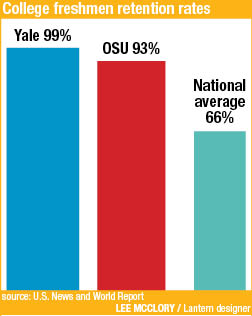Though some Ohio State officials insist the university’s 93 percent freshmen retention rate shows OSU is doing something right, the decision of whether to return wasn’t easy for some students.
Karli Shill is one such student. She transferred to OSU from Chapman University in California for Spring Semester 2013, but wasn’t happy with her decision.
“I really was just a body amongst 60,000 others,” said
Shill decided to transfer back to Chapman for Fall Semester 2013 and is now a third-year in sociology there.
Shill, whose parents live in the Columbus area, said after paying out-of-state tuition during her first year of college at Chapman, her parents had faced financial difficulties.
“I realized that in order to make it easier on my family, I should transfer to Ohio State because I would receive in-state tuition and have to take out much fewer student loans,” she said.
But although Shill attempted to join student organizations, she said her position as a transfer student made it hard to find her niche.
“I never really felt like I found my place on the campus,” she said.
Shill’s situation might be familiar to those who make up the 7 percent of students that leave OSU, Provost and Executive Vice President Joseph Steinmetz said.
“It’s not the case that they’re students that drop out of college. A fair majority of that 7 percent go on and transfer to other schools,” he said in an interview with The Lantern April 1. “I think that’s a big win (that of) 7 percent that don’t stay, they’re at least continuing on their education somewhere.”
And although some students end up leaving OSU, the university is working to boost its first-year retention rate from 93 percent to 95 percent in upcoming years.
In order to reach this goal, Dolan Evanovich, the vice president for strategic enrollment planning, said OSU plans to focus on personalizing students’ experiences and working harder to get them connected on campus.
“For each student it’s different,” he said, “(but) supporting them in their transition, helping them have a good first semester, getting them connected and involved, that really is our strategy.”
And unlike Shill, some students who had contemplated transferring out of OSU found reasons to stay.
Joanna Twist, a second-year in biochemistry from West Virginia, said she thought about transferring her first year because of a tough workload as an engineering major in the Fundamentals of Engineering Honors program.
“It was extremely difficult and I would be in the computer lab as early as 5 a.m. and wouldn’t get back to my dorm from studying until midnight,” Twist said. “I had never been so stressed in my life and I really wanted to go back home where I could de-stress and be reunited with all of my friends.”
Twist said she decided to remain at OSU because she switched her major to biochemistry, had a scholarship and got involved on campus. She said now she’s happier and less stressed.
“Ohio State has so many opportunities to offer to students,” she said.
Twist has been a leader of Buck-I-SERV, participated in undergraduate research and is a peer mentor in the chemistry department.
“I have something good going here and I would hate to leave now that I am so involved in these amazing opportunities,” she said.
But students like Nathan Dean, a first-year in international studies, remained at OSU for different reasons.
Dean, a member of Army ROTC, said his dream had always been to go to West Point Academy.
Although he said he has often considered transferring to West Point and always wanted the more structured environment that a military school typically aims to provide, OSU has allowed him to create his own structure.
“(By choosing ROTC) I can still become an officer in the military after college,” he said.
In addition, he said OSU’s size and community has challenged him to become more socially engaged.
“I wasn’t really good at the social aspects of things. Being immersed in a big school has really has helped,” he said.
Although Dean said OSU was not his first choice and he has not ruled out transferring in the future, he plans to remain at least a second year.
“Over time, my opinions have kind of changed. I like OSU a lot more now,” he said. “There’s plenty of opportunities here, there’s a lot of people to talk to and a lot of things that I want to do.”
For Steinmetz, OSU’s 93 percent first-year retention rate reflects that, like Dean, the majority of students are making connections and seeking out opportunities.
“The students that are coming here are finding what they want,” Steinmetz said. “It can always get better, but we’re doing pretty well.”



